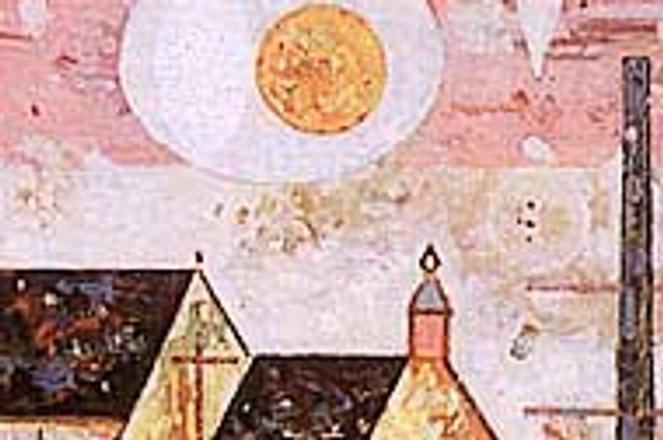FULLA'S Sun Over the Church, painted in 1965.photo: Courtesy of SNG
THE LIST of 24 artists currently displaying paintings, drawings, photographs and sculptures at the Slovak National Gallery (SNG) reads like a Who's Who of Slovak modern art. The project's aim is to celebrate the late painter Ľudovít Fulla's 100th birthday and his distinctive view of the Slovak people and their traditions.
"Fulla is one of the last significant Slovak painters to depict Slovakia as an entity in his art; where the mythical coexists with the actual and the fantastic intertwines with reality. In his pictures, Slovakia is idyllic, and yet industrialised and influenced by socialism," says the exhibition's curator Aurel Hrabušický.
Born in 1902, Fulla is considered one of the founders of modern Slovak art. From the very beginning of his career, he was inspired by folklorist art in general and wood-carved ornaments and religious iconography from eastern Slovakia in particular. His trademark was the conversion of these traditional themes into a modern form.
At the end of the 1950s, when the communist regime opposed any new or progressive forms of art, Fulla gave some of his works to the state. In return he was able to open his own gallery in the north-central Slovak town of Žilina.
Coincidentally, at this time a 'new wave' group of artists started to gather around another vibrant contemporary painter, Mikuláš Galanda, who also lived in Žilina. The town soon became one of the centres of fine art in Slovakia.
KOMPÁNEK'S Composition With a Pony.photo: Courtesy of SNG
Personal encounters with Fulla and his work served as a source of inspiration for the artists in the 'Galanda group'. Works by two of the leading personalities in the group, Vladimír Kompánek and Milan Laluha, are displayed prominently in the exhibition.
At first sight, the exhibition may seem incoherent because of the many different styles and techniques used, but a patient viewer will soon discover patterns. Most of the paintings' subjects are vertical objects, such as telegraph poles, pigeon houses, church towers, weeping willows and haystacks resembling the silhouettes of men and women working in fields.
"We wanted the common ideas [found in the works] to be visible. The pictures are arranged in such a way that they 'pass' the theme amongst themselves," said co-curator Alexandra Kusá.
All the works in this show, including the photographs, bear witness to an intense interest in the Slovak village; the simple architecture of the wooden cottages and the surrounding scenery of mountains and valleys. In this exhibit, documentary photographers Martin Martinček and Igor Plicka concentrate on details such as bridges, railings, piles of wood and scarecrows to show the character of the landscape.
"The original idea for this exhibition was to pay tribute to Fulla by asking modern Slovak artists to create works in his spirit. Instead, we decided to show his work in context and look for themes of the 'Slovak world' in the works of his contemporaries and followers," says Hrabušický.
While works of the different generations do not radically differ, those of the latest modernists show a more humourous approach to their subjects. The works of Martin Šútovec are represented by a series of paintings entitled From the Slovak Pantheon, portraying 'typical' Slovak characters: a thief, a fool and an idler.
Even though Fulla never explicitly stated that depicting Slovakia and its people was his artistic goal, the theme is evident in most of his works. Since the 1920s, Fulla's repeated folklorist motifs included brides and grooms and the legendary Slovak hero Jánošík.
What: Fulla and the Slovak World - exhibition.
Where: Slovenská národná galéria, Dvorana Ministerstva kultúry, (Slovak National Gallery, Exhibition Hall of the Ministry of Culture), Nám. SNP 33, Bratislava.
When: Tue-Sun 10:00-18:00 until January 5.
Admission: Sk30.
Tel: 02/5939-1170.


